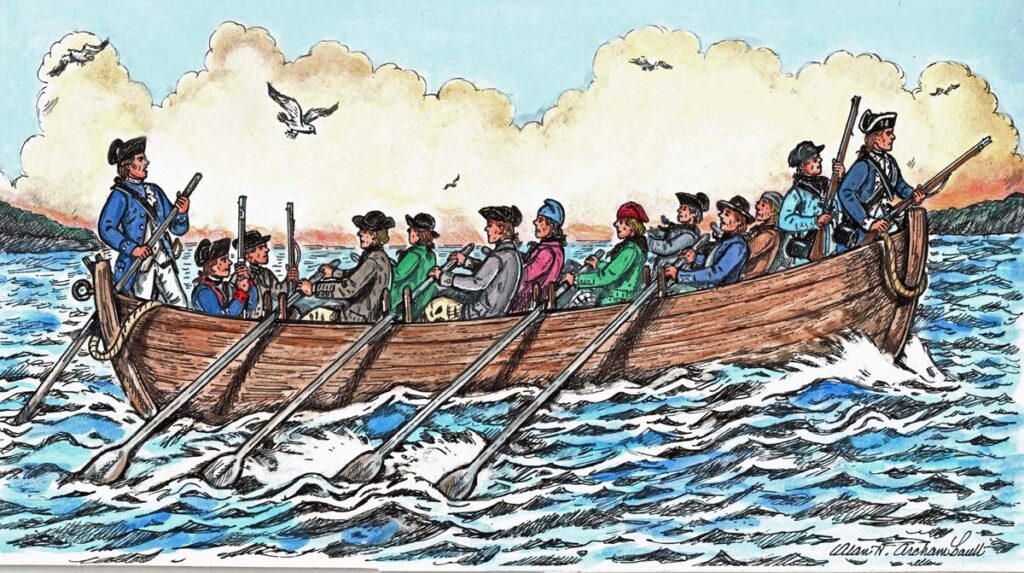Authors: Nick Pioppi (Boston Harbor Now | National Parks of Boston), Madilynn Nolen (Conservation Legacy)
The Boston Harbor Islands are an important part of Boston’s landscape in a variety of ways! They provide a place for visitors to gain a new perspective on the city and experience the biodiversity and geology of the harbor in a unique way. But did you know that they also played a key role in the fight for the occupation of Boston between British and Colonial forces? This contentious 11-month period was known as the Siege of Boston, and you can read on to learn more as we continue a celebration of 250th anniversaries of significant events from this period.
After the battles of Lexington and Concord on April 19th, 1775, the British military sought to restore order to the colonies and squash what they hoped to be a localized rebellion by besieging Boston. This strategy was considered ideal for two main reasons. First, land access to the city was restricted to an extremely narrow stretch of earth dubbed the “neck” of Boston, which could be easily held by just a handful of British forces. Second, the British Navy had overwhelming naval power in comparison with the Continental forces, making a counterattack from the harbor seem unlikely.

Caption: Can you find Long Wharf or Charlestown on this map? The shoreline that the colonists would have seen and lived with had dramatic differences compared to the one we know today. Visit the NPS Siege of Boston webpage for a map of the siege.
What the British forces did not count on, however, was the Colonialists’ creative use of whaleboats. These boats were very affordable, highly maneuverable, and could be purchased anywhere along the coast. Colonialists used whaleboats to launch a series of quick hit-and-run raids on the islands that the British were rarely able to retaliate against due to the evasive abilities of the small crafts and surprise nature of the raids. One such raid took place on July 11th, 1775, about a month after the battle of Bunker Hill. Militiamen used whaleboats to land on Long Island where they captured livestock, burned British provisions, and even took several prisoners of war.

[Whaleboat image (artist Alan H Archambault) Caption: Small, highly maneuverable whaleboats like the one featured above allowed colonialists to quickly sneak on and off the Harbor Islands, disrupting British operations and securing supplies.]
Abigail Adams describes the Long Island raid in a letter to her husband on July 16th:
“There has been a little Expidition [sic] this week to Long Island. […] A number of whale boats lay at Germantown; 300 volenters [sic]… came on monday [sic] evening and took the boats, went on and brought of 70 odd Sheep, 15 head of cattle, and 16 prisoners… Some other volenters [sic] to the amount of an 100… went on, set fire to the [house and barn] and Hay. […] Many in this Town who were spectators expected every moment our Men would all be sacrificed… yet they all returnd [sic] in safty [sic], not one Man even wounded.”
The Long Island Raid gives us an excellent example of the different methods employed by colonialists to counter British authority during the siege. Through this and similar attacks on Grape, Noddles, Deer, Peddocks, and many other islands, the British grip on Boston and its surrounding areas was weakened further and further, while Washington’s troops worked to fortify Dorchester Heights. Finally, in early March 1776, the Continental Army had officially arrived in Boston. Armed with canons and in possession of the high ground, a major tactical advantage, they prepared to take back the city from the British (Interested in helping the celebration of the 250th anniversary of this historic event? Click here).
![[Dorchester heights (NPS Image) Caption: The Dorchester Heights monument reopened after an extensive conservation project in preparation for the 250th anniversary of Evacuation Day in March of 2026.]](https://www.bostonharbornow.org/wp-content/uploads/2025/11/33d13563-160b-4ae2-a470-2429a1e93d08HiResProxy-1024x683.jpg) [Dorchester heights (NPS Image) Caption: The Dorchester Heights monument reopened after an extensive conservation project in preparation for the 250th anniversary of Evacuation Day in March of 2026.]
[Dorchester heights (NPS Image) Caption: The Dorchester Heights monument reopened after an extensive conservation project in preparation for the 250th anniversary of Evacuation Day in March of 2026.]
Facing increasing pressure from both land and sea, the British army realized that they would no longer be able to hold the city of Boston. They officially evacuated on March 17th, 1776, ending the eight-year occupation of the city by British forces. Evacuation Day remains an official holiday in the commonwealth to this day, and we will be acknowledging its 250th anniversary in 2026! To keep abreast of this and other 250th anniversaries, check both the BHN website and the 250th Anniversary of the American Revolution web page from our partners at National Parks of Boston.
Land Acknowledgment: The Boston Harbor Islands have a diverse history beyond European settlement and have been important to every group who call Boston home. Check out more information about the islands’ importance to local indigenous groups here: Indigenous History and Ways of Knowing – Boston Harbor Islands National and State Park

Comments